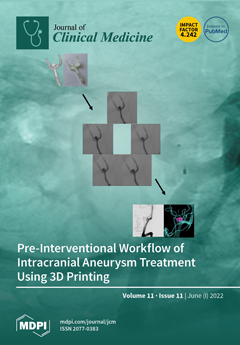Background: Aneurysm shrinkage has been proposed as a marker of successful endovascular aneurysm repair (EVAR). We evaluated the impact of sac shrinkage on secondary interventions, on survival and its association with endoleaks, and on compliance with instructions for use (IFU).
Methods: This observational
[...] Read more.
Background: Aneurysm shrinkage has been proposed as a marker of successful endovascular aneurysm repair (EVAR). We evaluated the impact of sac shrinkage on secondary interventions, on survival and its association with endoleaks, and on compliance with instructions for use (IFU).
Methods: This observational retrospective study was conducted on all consecutive patients receiving EVAR for an infrarenal abdominal aortic aneurysm (AAA) using exclusively Endurant II/IIs endograft from 2014 to 2018. Sixty patients were entered in the study. Aneurysm sac shrinkage was defined as decrease ≥5 mm of the maximum aortic diameter. Univariate methods and Kaplan–Meier plots assessed the potential impact of shrinkage.
Results: Twenty-six patients (43.3%) experienced shrinkage at one year, and thirty-four (56.7%) had no shrinkage. Shrinkage was not significantly associated with any demographics or morbidity, except hypertension (
p = 0.01). No aneurysm characteristics were associated with shrinkage. Non-compliance with instructions for use (IFU) in 13 patients (21.6%) was not associated with shrinkage. Three years after EVAR, freedom from secondary intervention was 85 ± 2% for the entire series, 92.3 ± 5.0% for the shrinkage group and 83.3 ± 9% for the no-shrinkage group (Logrank:
p = 0.49). Survival at 3 years was not significantly different between the two groups (85.9 ± 7.0% vs. 79.0 ± 9.0%, Logrank;
p = 0.59). Strict compliance with IFU was associated with less reinterventions at 3 years (92.1 ± 5.9% vs. 73.8 ± 15%, Logrank:
p = 0.03). Similarly, survival at 3 years did not significantly differ between strict compliance with IFU and non-compliance (81.8 ± 7.0% vs. 78.6 ± 13.0%, Logrank;
p = 0.32).
Conclusion: This study suggests that shrinkage ≥5 mm at 1-year is not significantly associated with a better survival rate or a lower risk of secondary intervention than no-shrinkage. In this series, the risk of secondary intervention regardless of shrinkage seems to be linked more to non-compliance with IFU. Considering the small number of patients, these results must be confirmed by extensive prospective studies.
Full article






